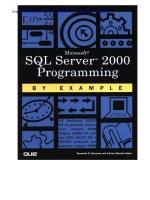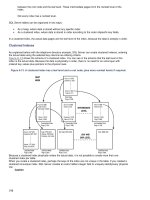Foreword và Predace của VHDL Programming by Example 4th Edition_01
Bạn đang xem bản rút gọn của tài liệu. Xem và tải ngay bản đầy đủ của tài liệu tại đây (45.89 KB, 6 trang )
FOREWORD
VHDL has been at the heart of electronic design productivity since ini-
tial ratification by the IEEE in 1987. For almost 15 years the electronic
design automation industry has expanded the use of VHDL from initial
concept of design documentation, to design implementation and func-
tional verification. It can be said that VHDL fueled modern synthesis
technology and enabled the development of ASIC semiconductor compa-
nies. The editions of Doug Perry’s books have served as the authoritative
source of practical information on the use of VHDL for users of the
language around the world.
The use of VHDL has evolved and its importance increased as semi-
conductor devices dimensions have shrunk. Not more than 10 years ago it
was common to mix designs described with schematics and VHDL. But as
design complexity grew, the industry abandoned schematics in favor of the
hardware description language only. The successive revisions of this book
have always kept pace with the industry’s evolving use of VHDL.
The fact that VHDL is adaptable is a tribute to its architecture. The
industry has seen the use of VHDL’s package structure to allow design-
ers, electronic design automation companies and the semiconductor indus-
try to experiment with new language concepts to ensure good design tool
and data interoperability. When the associated data types found in the
IEEE 1164 standard were ratified, it meant that design data interoper-
ability was possible.
All of this was facilitated by industry backing in a consortium of systems,
electronic design automation and semiconductor companies now known
as Accellera.
And when the ASIC industry needed a standard way to convey gate-
level design data and timing information in VHDL, one of Accellera’s
progenitors (VHDL International) sponsored the IEEE VHDL team to
build a companion standard. The IEEE 1076.4 VITAL (VHDL Initiative
Towards ASIC Libraries) was created and ratified as offers designers a
single language flow from concept to gate-level signoff.
In the late ’90s, the Verilog HDL and VHDL industry standards teams
collaborated on the use of a common timing data such as IEEE 1497 SDF,
set register transfer level (RTL) standards and more to improve design
methodologies and the external connections provided to the hardware
description languages.
But from the beginning, the leadership of the VHDL community has
assured open and internationally accredited standards for the electronic
design engineering community. The legacy of this team’s work continues
to benefit the design community today as the benchmark by which one
measures openness.
The design community continues to see benefits as the electronic design
automation community continues to find new algorithms to work from
VHDL design descriptions and related standards to again push designer
productivity. And, as a new generation of designers of programmable logic
devices move to the use of hardware description languages as the basis of
their design methodology, there will be substantial growth in the number
of VHDL users.
This new generation of electronic designers, along with the current
designers of complex systems and ASICs, will find this book as invalu-
able as the first generation of VHDL users did with the first addition.
Updated with current use of the standard, all will benefit from the years
of use that have made the VHDL language the underpinning of successful
electronic design.
Dennis B. Brophy
Chair, Accellera
Foreword
xiv
PREFACE
This is the fourth version of the book and this version now not only provides
VHDL language coverage but design methodology information as well. This
version will guide the reader through the process of creating a VHDL
design, simulating the design, synthesizing the design, placing and routing
the design, using VITAL simulation to verify the final result, and a new
technique called At-Speed debugging that provides extremely fast design
verification. The design example in this version has been updated to reflect
the new focus on the design methodology.
This book was written to help hardware design engineers learn how to
write good VHDL design descriptions. The goal is to provide enough VHDL
and design methodology information to enable a designer to quickly write
good VHDL designs and be able to verify the results. It will also attempt
to bring the designer with little or no knowledge of VHDL, to the level of
writing complex VHDL descriptions. It is not intended to show every pos-
sible construct of VHDL in every possible use, but rather to show the de-
signer how to write concise, efficient, and correct VHDL descriptions of
hardware designs.
This book is organized into three logical sections. The first section of the
book will introduce the VHDL language, the second section walks through
a VHDL based design process including simulation, synthesis, place and
route, and VITAL simulation; and the third section walks through a design
example of a small CPU design from VHDL capture to final gate-level
implementation, and At-Speed debugging. At the back of the book are
included a number of appendices that contain useful information about the
language and examples used throughout the book.
In the first section VHDL features are introduced one or more at a time.
As each feature is introduced, one or more real examples are given to show
how the feature would be used. The first section consists of Chapters 1
through 8, and each chapter introduces a basic description capability of
VHDL. Chapter 1 discusses how VHDL design relates to schematic based
design, and introduces the basic terms of the language. Chapter 2 describes
some of the basic concepts of VHDL, including the different delay mecha-
nisms available, how to use instance specific data, and defines VHDL dri-
vers. Chapter 2 discusses concurrent statements while Chapter 3 introduces
the reader to VHDL sequential statements. Chapter 4 talks about the wide
Preface
xvi
range of types available for use in VHDL. Examples are given for each of
the types showing how they would be used in a real example. In Chapter
5 the concepts of subprograms and packages are introduced. The different
uses for functions are given, as well as the features available in VHDL
packages.
Chapter 6 introduces the five kinds of VHDL attributes. Each attribute
kind has examples describing how to use the specific attribute to the
designer’s best advantage. Examples are given which describe the pur-
pose of each of the attributes.
Chapters 7 and 8 will introduce some of the more advanced VHDL
features to the reader. Chapter 7 discusses how VHDL configurations
can be used to construct and manage complex VHDL designs. Each of
the different configuration styles are discussed along with examples
showing usage. Chapter 8 introduces more of the VHDL advanced top-
ics with discussions of overloading, user defined attributes, generate
statements, and TextIO.
The second section of the book consists of Chapters 9 through 11. Chap-
ters 9 and 10 discuss the synthesis process and how to write synthesiz-
able designs. These two chapters describe the basics of the synthesis
process including how to write synthesizeable VHDL, what is a technol-
ogy library, what does the synthesis process look like, what are con-
straints and attributes, and what does the the optimization process look
like. Chapter 11 discusses the complete high level design flow from VHDL
capture through VITAL simulation.
The third section of the book walks through a description of a small
CPU design from the VHDL capture through simulation, synthesis, place
and route, and VITAL simulation. Chapter 12 describes the top level of
the CPU design from a functional point of view. In Chapter 13 the RTL
description of the CPU is presented and discussed from a synthesis point
of view. Chapter 14 begins with a discussion of VHDL testbenches and
how they are used to verify functionality. Chapter 14 finishes the discus-
sion by describing the simulation of the CPU design. In Chapter 15 the
verified design is synthesized to a target technology. Chapter 16 takes
the synthesized design and places and routes the design to a target
device. Chapter 17 begins with a discussion of VITAL and ends with the
VITAL simulation of the placed and routed CPU design. Chapter 18 is a
new chapter that discusses the new technique of At-Speed debugging.
This chapter provides the reader with an in-depth look at how a hardware
implementation of the CPU design can help speed verification.
Finally there are three appendices at the end of the book to provide ref-
erence information. Appendix A is a listing of the IEEE 1164 STD_LOGIC
package used throughout the book. Appendix B is a set of useful tables
that condense some of the information in the rest of the book into quick
reference tables. Finally, Appendix C describes how to read the Bachus-
Naur format(BNF) descriptions found in the VHDL Language Reference
Manual. I can only hope that you the reader will have as much fun read-
ing this book and working with VHDL as I did in writing it.
xvii
Preface









